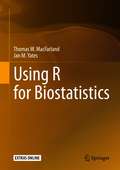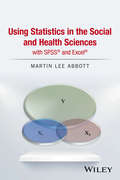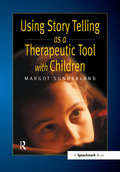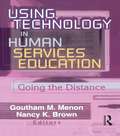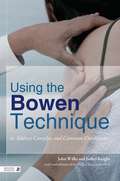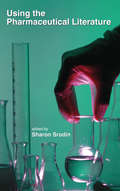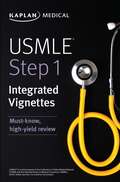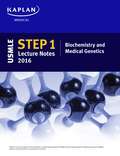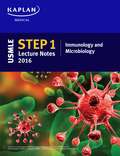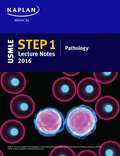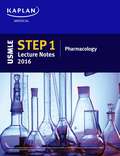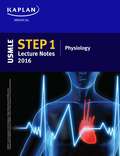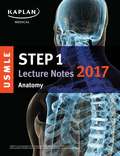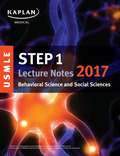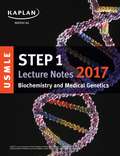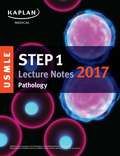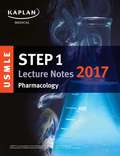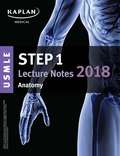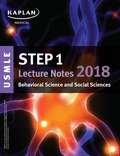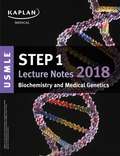- Table View
- List View
Using Personal Judgement in Nursing and Healthcare
by Professor David Seedhouse Vanessa PeuthererWhat is personal judgement? How can it help me interpret and follow official guidelines? How can I use it successfully in my daily practice? Rules and codes for healthcare professionals continue to proliferate yet are unable to offer practical advice in specific circumstances. To help balance official rules with the variable, unique human element, David Seedhouse and Vanessa Peutherer explain what personal judgement is and how it can be applied routinely and effectively in everyday decision-making in healthcare. Through the use of over 40 interactive scenarios drawn from real-life practice, the authors encourage readers to use a range of techniques to boost their personal judgement, introducing 11 different models and approaches to decision-making and exploring their strengths as well as their limitations. The authors then talk through their own suggestions for solving commonplace but challenging healthcare problems. Timely, original and accessible, this book provides nurses and healthcare professionals with the tools needed to navigate the reality of everyday practice, while working with the many protocols they must consider and apply in both education and practice.
Using R for Biostatistics
by Thomas W. MacFarland Jan M. YatesThis book introduces the open source R software language that can be implemented in biostatistics for data organization, statistical analysis, and graphical presentation. In the years since the authors’ 2014 work Introduction to Data Analysis and Graphical Presentation in Biostatistics with R, the R user community has grown exponentially and the R language has increased in maturity and functionality. This updated volume expands upon skill-sets useful for students and practitioners in the biological sciences by describing how to work with data in an efficient manner, how to engage in meaningful statistical analyses from multiple perspectives, and how to generate high-quality graphics for professional publication of their research. A common theme for research in the diverse biological sciences is that decision-making depends on the empirical use of data. Beginning with a focus on data from a parametric perspective, the authors address topics such as Student t-Tests for independent samples and matched pairs; oneway and twoway analyses of variance; and correlation and linear regression. The authors also demonstrate the importance of a nonparametric perspective for quality assurance through chapters on the Mann-Whitney U Test, Wilcoxon Matched-Pairs Signed-Ranks test, Kruskal-Wallis H-Test for Oneway Analysis of Variance, and the Friedman Twoway Analysis of Variance. To address the element of data presentation, the book also provides an extensive review of the many graphical functions available with R. There are now perhaps more than 15,000 external packages available to the R community. The authors place special emphasis on graphics using the lattice package and the ggplot2 package, as well as less common, but equally useful, figures such as bean plots, strip charts, and violin plots. A robust package of supplementary material, as well as an introduction of the development of both R and the discipline of biostatistics, makes this ideal for novice learners as well as more experienced practitioners.
Using Statistics in the Social and Health Sciences with SPSS and Excel
by Martin Lee AbbottProvides a step-by-step approach to statistical procedures to analyze data and conduct research, with detailed sections in each chapter explaining SPSS® and Excel® applications This book identifies connections between statistical applications and research design using cases, examples, and discussion of specific topics from the social and health sciences. Researched and class-tested to ensure an accessible presentation, the book combines clear, step-by-step explanations for both the novice and professional alike to understand the fundamental statistical practices for organizing, analyzing, and drawing conclusions from research data in their field. The book begins with an introduction to descriptive and inferential statistics and then acquaints readers with important features of statistical applications (SPSS and Excel) that support statistical analysis and decision making. Subsequent chapters treat the procedures commonly employed when working with data across various fields of social science research. Individual chapters are devoted to specific statistical procedures, each ending with lab application exercises that pose research questions, examine the questions through their application in SPSS and Excel, and conclude with a brief research report that outlines key findings drawn from the results. Real-world examples and data from social and health sciences research are used throughout the book, allowing readers to reinforce their comprehension of the material. Using Statistics in the Social and Health Sciences with SPSS® and Excel® includes: * Use of straightforward procedures and examples that help students focus on understanding of analysis and interpretation of findings * Inclusion of a data lab section in each chapter that provides relevant, clear examples * Introduction to advanced statistical procedures in chapter sections (e.g., regression diagnostics) and separate chapters (e.g., multiple linear regression) for greater relevance to real-world research needs Emphasizing applied statistical analyses, this book can serve as the primary text in undergraduate and graduate university courses within departments of sociology, psychology, urban studies, health sciences, and public health, as well as other related departments. It will also be useful to statistics practitioners through extended sections using SPSS® and Excel® for analyzing data. Martin Lee Abbott, PhD, is Professor of Sociology at Seattle Pacific University, where he has served as Executive Director of the Washington School Research Center, an independent research and data analysis center funded by the Bill & Melinda Gates Foundation. Dr. Abbott has held positions in both academia and industry, focusing his consulting and teaching in the areas of statistical procedures, program evaluation, applied sociology, and research methods. He is the author of Understanding Educational Statistics Using Microsoft Excel® and SPSS®, The Program Evaluation Prism: Using Statistical Methods to Discover Patterns, and Understanding and Applying Research Design, also from Wiley.
Using Story Telling as a Therapeutic Tool with Children (Helping Children with Feelings)
by Margot SunderlandThis practical handbook begins with the philosophy and psychology underpinning the therapeutic value of story telling. It shows how to use story telling as a therapeutic tool with children and how to make an effective response when a child tells a story to you. It is an essential accompaniment to the "Helping Children with Feelings" series and covers issues such as: Why story telling is such a good way of helping children with their feelings? What resources you may need in a story-telling session? How to construct your own therapeutic story for a child? What to do when children tell stories to you? Things to do and say when working with a child's story.
Using Technology in Human Services Education: Going the Distance
by Goutham Menon Nancy K. BrownMake the most of what today&’s technology has to offer in human services education!Distance education presents special challenges to social work education. Using Technology in Human Services Education: Going the Distance provides case studies and practical research on making the best use of this powerful new tool for teaching. Designed for both practitioners and educators, this fascinating book examines the use of technology in education and practice in the field of social work and other human services. Because setting up distance-learning programs can be expensive, Using Technology in Human Services Education suggests ways to reduce the impact on the budget, including setting up a consortium to merge resources with other schools. It also shows how to integrate traditional instructional approaches with the new technologies, how to make use of email and electronic discussion groups, and how to use the Internet to hone practice-related skills. In addition, it covers the current status of the technology itself.Using Technology in Human Services Education: Going the Distance explores ways to maximize the potential of distance education, such as: a framework for designing distance education courses that fully utilize the unique environments these courses offer a discussion of the impact of technological tools in teaching specific course content ways that SACs (Site Advisory Committees) can increase students&’ socialization into their new professions ways that students need to be supported in order to feel a connection to a distance-learning program the use of GIS (Geographic Information Systems) to help meet and identify the information needs of a field placement agencyUsing Technology in Human Services Education offers creative approaches and practical advice for making the best use of the technology. Whatever your level of computer skill, from novice to hacker, this book will give you ideas you can use. No individual or institution interested in maintaining top quality in human services education should be without this book!
Using the Bowen Technique to Address Complex and Common Conditions
by John Wilks Isobel KnightThe Bowen technique resets and repairs the body, restoring balance to relieve pain and improve energy. This book shows how it can be particularly effective at alleviating conditions that are renowned for being difficult to treat, as well as at enhancing performance in dance and other sports. Covering lower back pain, frozen shoulder, tennis elbow, carpal tunnel, hayfever, asthma, diabetes (type 2), migraines, stress and tension disorders, fibromyalgia, chronic fatigue, palliative care, performance enhancement, and in pre and post-natal care, clinical case studies reveal Bowen technique in action along with detailed explanations of how and why Bowen is so effective for each of these different situations. This is the perfect book for Bowen practitioners, and other complementary and alternative health practitioners and medical professionals wanting to know how and why the Bowen technique can help their patients, as well as patients interested in learning about what Bowen can do for them.
Using the Pharmaceutical Literature
by Sharon SrodinGathering information of critical importance for professionals in the pharmaceutical and medical device industries, this guide provides a comprehensive overview of key resources, such as databases, on-line directories, reports, and periodicals-providing at-a-glance guidance and collection development tools for information professionals in this fiel
USMLE Step 1: Must-know, high-yield review (USMLE Prep)
by Kaplan MedicalKaplan Medical's USMLE Step 1 Integrated Vignettes provides must-know, high-yield facts for the Step 1 exam. A "question bank in book format," this portable tool will help you bridge the gap between preclinical coursework and Qbank usage. The focus is on integrated cases and differential diagnoses, along with practical clinical correlations.High-Yield ReviewChecklist of pathological processes within each organ systemClinical vignettes with high-yield explanations of conditionsTen representative diseases detailing morphologic features and differential diagnosesPhysiology and pharmacology correlations for every diseasePractice questions for self-assessment
USMLE Step 1 Lecture Notes 2016: Anatomy
by KaplanThe only official Kaplan Lecture Notes for USMLE Step 1 available for sale! Get the comprehensive information you need to ace USMLE Step 1 and match into the residency of your choice. * Up-to-date: Updated annually by Kaplan's all-star faculty * Integrated: Packed with clinical correlations and bridges between disciplines * Learner-efficient: Organized in outline format with high-yield summary boxes * Trusted: Used by thousands of students each year to succeed on USMLE Step 1
USMLE Step 1 Lecture Notes 2016: Behavioral Science and Social Sciences
by KaplanThe only official Kaplan Lecture Notes for USMLE Step 1 available for sale! Get the comprehensive information you need to ace USMLE Step 1 and match into the residency of your choice. * Up-to-date: Updated annually by Kaplan's all-star faculty * Integrated: Packed with clinical correlations and bridges between disciplines * Learner-efficient: Organized in outline format with high-yield summary boxes * Trusted: Used by thousands of students each year to succeed on USMLE Step 1
USMLE Step 1 Lecture Notes 2016: Biochemistry and Medical Genetics
by KaplanThe only official Kaplan Lecture Notes for USMLE Step 1 available for sale! Get the comprehensive information you need to ace USMLE Step 1 and match into the residency of your choice. * Up-to-date: Updated annually by Kaplan's all-star faculty * Integrated: Packed with clinical correlations and bridges between disciplines * Learner-efficient: Organized in outline format with high-yield summary boxes * Trusted: Used by thousands of students each year to succeed on USMLE Step 1
USMLE Step 1 Lecture Notes 2016: Immunology and Microbiology
by KaplanThe only official Kaplan Lecture Notes for USMLE Step 1 available for sale! Get the comprehensive information you need to ace USMLE Step 1 and match into the residency of your choice. * Up-to-date: Updated annually by Kaplan's all-star faculty * Integrated: Packed with clinical correlations and bridges between disciplines * Learner-efficient: Organized in outline format with high-yield summary boxes * Trusted: Used by thousands of students each year to succeed on USMLE Step 1
USMLE Step 1 Lecture Notes 2016: Pathology
by KaplanThe only official Kaplan Lecture Notes for USMLE Step 1 available for sale! Get the comprehensive information you need to ace USMLE Step 1 and match into the residency of your choice. * Up-to-date: Updated annually by Kaplan's all-star faculty * Integrated: Packed with clinical correlations and bridges between disciplines * Learner-efficient: Organized in outline format with high-yield summary boxes * Trusted: Used by thousands of students each year to succeed on USMLE Step 1
USMLE Step 1 Lecture Notes 2016: Pharmacology
by KaplanThe only official Kaplan Lecture Notes for USMLE Step 1 available for sale! Get the comprehensive information you need to ace USMLE Step 1 and match into the residency of your choice. * Up-to-date: Updated annually by Kaplan's all-star faculty * Integrated: Packed with clinical correlations and bridges between disciplines * Learner-efficient: Organized in outline format with high-yield summary boxes * Trusted: Used by thousands of students each year to succeed on USMLE Step 1
USMLE Step 1 Lecture Notes 2016: Physiology
by KaplanThe only official Kaplan Lecture Notes for USMLE Step 1 available for sale! Get the comprehensive information you need to ace USMLE Step 1 and match into the residency of your choice. * Up-to-date: Updated annually by Kaplan's all-star faculty * Integrated: Packed with clinical correlations and bridges between disciplines * Learner-efficient: Organized in outline format with high-yield summary boxes * Trusted: Used by thousands of students each year to succeed on USMLE Step 1
USMLE Step 1 Lecture Notes 2017: Anatomy
by Kaplan MedicalThe only official Kaplan Lecture Notes for USMLE Step 1 cover the comprehensive information you need to ace the exam and match into the residency of your choice. * Up-to-date: Updated annually by Kaplan’s all-star faculty * Integrated: Packed with clinical correlations and bridges between disciplines * Learner-efficient: Organized in outline format with high-yield summary boxes * Trusted: Used by thousands of students each year to succeed on USMLE Step 1
USMLE Step 1 Lecture Notes 2017: Behavioral Science and Social Sciences
by Kaplan MedicalThe only official Kaplan Lecture Notes for USMLE Step 1 cover the comprehensive information you need to ace the exam and match into the residency of your choice. * Up-to-date: Updated annually by Kaplan’s all-star faculty. This edition includes a section on Patient Safety Science, a topic that was recently added to the exam. * Integrated: Packed with clinical correlations and bridges between disciplines * Learner-efficient: Organized in outline format with high-yield summary boxes * Trusted: Used by thousands of students each year to succeed on USMLE Step 1
USMLE Step 1 Lecture Notes 2017: Biochemistry and Medical Genetics
by Kaplan MedicalThe only official Kaplan Lecture Notes for USMLE Step 1 cover the comprehensive information you need to ace the exam and match into the residency of your choice. * Up-to-date: Updated annually by Kaplan’s all-star faculty * Integrated: Packed with clinical correlations and bridges between disciplines * Learner-efficient: Organized in outline format with high-yield summary boxes * Trusted: Used by thousands of students each year to succeed on USMLE Step 1
USMLE Step 1 Lecture Notes 2017: Immunology and Microbiology
by Kaplan MedicalThe only official Kaplan Lecture Notes for USMLE Step 1 cover the comprehensive information you need to ace the exam and match into the residency of your choice. * Up-to-date: Updated annually by Kaplan’s all-star faculty * Integrated: Packed with clinical correlations and bridges between disciplines * Learner-efficient: Organized in outline format with high-yield summary boxes * Trusted: Used by thousands of students each year to succeed on USMLE Step 1
USMLE Step 1 Lecture Notes 2017: Pathology
by Kaplan MedicalThe only official Kaplan Lecture Notes for USMLE Step 1 cover the comprehensive information you need to ace the exam and match into the residency of your choice. * Up-to-date: Updated annually by Kaplan’s all-star faculty * Integrated: Packed with clinical correlations and bridges between disciplines * Learner-efficient: Organized in outline format with high-yield summary boxes * Trusted: Used by thousands of students each year to succeed on USMLE Step 1
USMLE Step 1 Lecture Notes 2017: Pharmacology
by Kaplan MedicalThe only official Kaplan Lecture Notes for USMLE Step 1 cover the comprehensive information you need to ace the exam and match into the residency of your choice. * Up-to-date: Updated annually by Kaplan’s all-star faculty * Integrated: Packed with clinical correlations and bridges between disciplines * Learner-efficient: Organized in outline format with high-yield summary boxes * Trusted: Used by thousands of students each year to succeed on USMLE Step 1
USMLE Step 1 Lecture Notes 2017: Physiology
by Kaplan MedicalThe only official Kaplan Lecture Notes for USMLE Step 1 cover the comprehensive information you need to ace the exam and match into the residency of your choice. * Up-to-date: Updated annually by Kaplan’s all-star faculty * Integrated: Packed with clinical correlations and bridges between disciplines * Learner-efficient: Organized in outline format with high-yield summary boxes * Trusted: Used by thousands of students each year to succeed on USMLE Step 1
USMLE Step 1 Lecture Notes 2018: Anatomy
by Kaplan MedicalKaplan Medical's USMLE Step 1 Lecture Notes 2018: Anatomy offers in-depth review with a focus on high-yield topics – a comprehensive approach that will help you deepen your understanding while focusing your efforts where they'll count the most.Used by thousands of medical students each year to succeed on USMLE Step 1, Kaplan's official lecture notes are packed with full-color diagrams and clear review.The Best ReviewOrganized in outline format with high-yield summary boxes for efficient study.Clinical correlations and bridges between disciplines highlighted throughout.Full-color diagrams and charts for better comprehension and retention.Updated annually by Kaplan's all-star expert facultyLooking for more prep? Our USMLE Step 1 Lecture Notes 2018: 7-Book Set has this book, plus the rest of the 7-book series.
USMLE Step 1 Lecture Notes 2018: Behavioral Science and Social Sciences
by Kaplan MedicalKaplan Medical's USMLE Step 1 Lecture Notes 2018: Behavioral Science and Social Sciences offers in-depth review with a focus on high-yield topics – a comprehensive approach that will help you deepen your understanding while focusing your efforts where they'll count the most.Used by thousands of medical students each year to succeed on USMLE Step 1, Kaplan's official lecture notes are packed with full-color diagrams and clear review. This edition includes a section on Patient Safety Science, a topic that was recently added to the exam.The Best ReviewOrganized in outline format with high-yield summary boxes for efficient study.Clinical correlations and bridges between disciplines highlighted throughout.Full-color diagrams and charts for better comprehension and retention.Updated annually by Kaplan's all-star expert facultyLooking for more prep? Our USMLE Step 1 Lecture Notes 2018: 7-Book Set has this book, plus the rest of the 7-book series.
USMLE Step 1 Lecture Notes 2018: Biochemistry and Medical Genetics
by Kaplan MedicalKaplan Medical's USMLE Step 1 Lecture Notes 2018: Biochemistry and Medical Genetics offers in-depth review with a focus on high-yield topics – a comprehensive approach that will help you deepen your understanding while focusing your efforts where they'll count the most.Used by thousands of medical students each year to succeed on USMLE Step 1, Kaplan's official lecture notes are packed with full-color diagrams and clear review.The Best ReviewOrganized in outline format with high-yield summary boxes for efficient study.Clinical correlations and bridges between disciplines highlighted throughout.Full-color diagrams and charts for better comprehension and retention.Updated annually by Kaplan's all-star expert facultyLooking for more prep? Our USMLE Step 1 Lecture Notes 2018: 7-Book Set has this book, plus the rest of the 7-book series.

